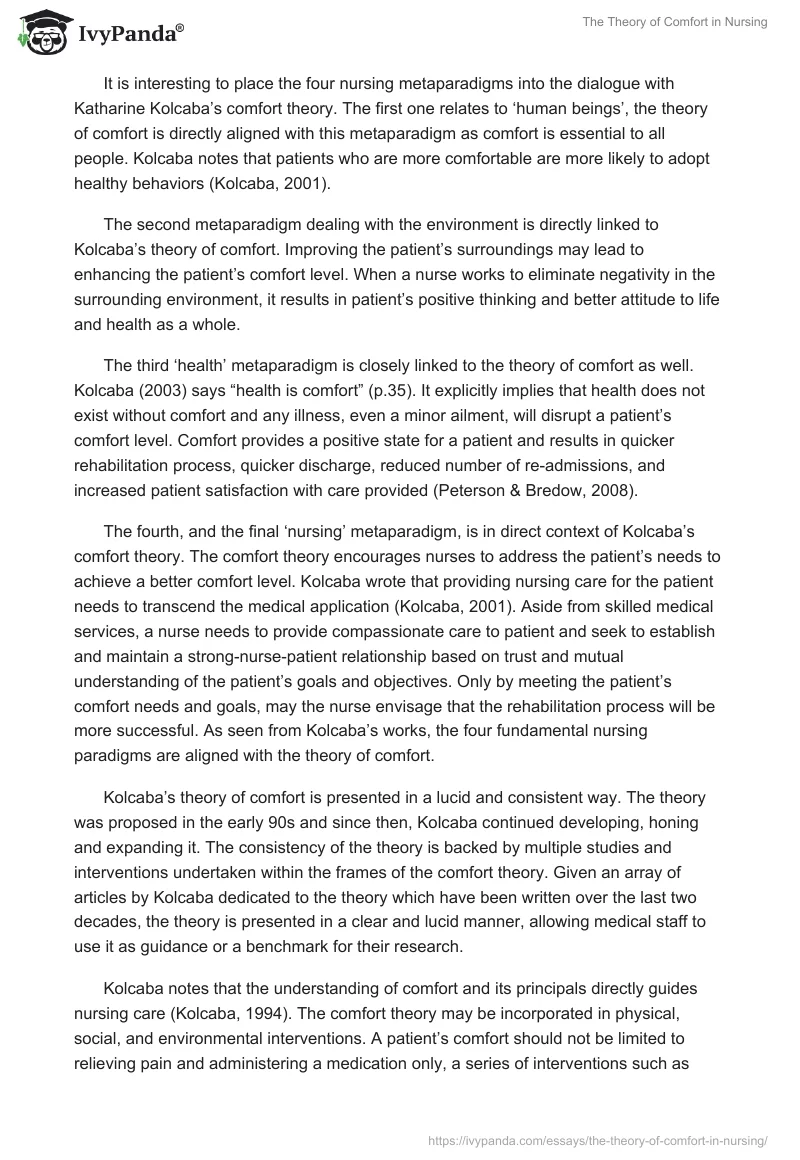
Interventions and practices using Comfort Theory of Kolcaba to
4.8 (728) In stock

4.8 (728) In stock
Background Comfort is a primary patient objective and central to patient experience, and thus, maximising comfort is a universal goal for healthcare. However, comfort is a complex concept that is difficult to operationalise and evaluate, resulting in a lack of scientific and standardised comfort care practices. The Comfort Theory developed by Kolcaba has been the most widely known for its systematisation and projection and most of the global publications regarding comfort care were based on this theory. To develop international guidance on theory-informed comfort care, a better understanding about the evidence on the effects of interventions guided by the Comfort Theory is needed. Objectives To map and present the available evidence on the effects of interventions underpinned by Kolcaba’s Comfort theory in healthcare settings. Methods The mapping review will follow Campbell Evidence and Gap Maps guideline and Preferred Reporting Items for Systematic Reviews and Meta-Analyses extension for Scoping Reviews Protocols guidelines. An intervention-outcome framework has been developed based on Comfort Theory and the classification of pharmacological and non-pharmacological interventions via consultation with stakeholders. Eleven electronic databases (MEDLINE, CINAHL, PsycINFO, Embase, AMED, Cochrane Library, JBI Library of Systematic Reviews, Web of Science, Scopus, CNKI and Wan Fang) and grey literature sources (Google Scholar, Baidu Scholar and The Comfort Line) will be searched for primary studies and systematic reviews between 1991 and 2023 written in English and Chinese as the papers regarding Comfort Theory were first published in 1991. Additional studies will be identified by reference list review of included studies. Key authors will be contacted for unpublished or ongoing studies. Two independent reviewers will screen and extract data using piloted forms with discrepancies resolved by discussion with a third reviewer. A matrix map with filters of study characteristics will be generated and presented through software of EPPI-Mapper and NVivo. Discussion More informed use of theory can strengthen improvement programmes and facilitate the evaluation of their effectiveness. Findings from the evidence and gap map will present the existing evidence base for researchers, practitioners and policy-makers and inform further research as well as clinical practices aiming at patients’ comfort enhancement.

The Theory of Comfort in Nursing - 2241 Words

33. Theory of comfort

Awatson Aprns State REG Paper - APRNs and State Regulations Alexia Watson Herzing University NU626 - Studocu

Integration of Nursing Theories in Advanced FNP Practice: Name Institution Course Date, PDF, Nursing
Katharine Kolcaba′s Comfort Theory

Patients' perspectives on comfort and influencing factors; the Comfort

Sharing Resources to Disseminate Knowledge and Improve Comfort

SOLUTION: Katharine kolcaba s comfort theory - Studypool

Taxonomic Structure of Comfort Needs Applied

SOLUTION: Orem s theory of self care and kolcaba s theory of

Contribution from Katharine Kolcaba on the importance of comfort
Systematic Reviews 影响因子3.700分,是几区,2022-2023年期刊投稿经验分享,Systematic Reviews主页,推荐审稿人、编辑,审稿周期/时间,版面费多少,中国作者发表文章,修改意见

Taxonomic Structure of Comfort Needs Applied

Taxonomic Structure of Comfort Theory - New Nurse Education

27, June, 2013, Katharine Kolcaba: The Comfort Theory